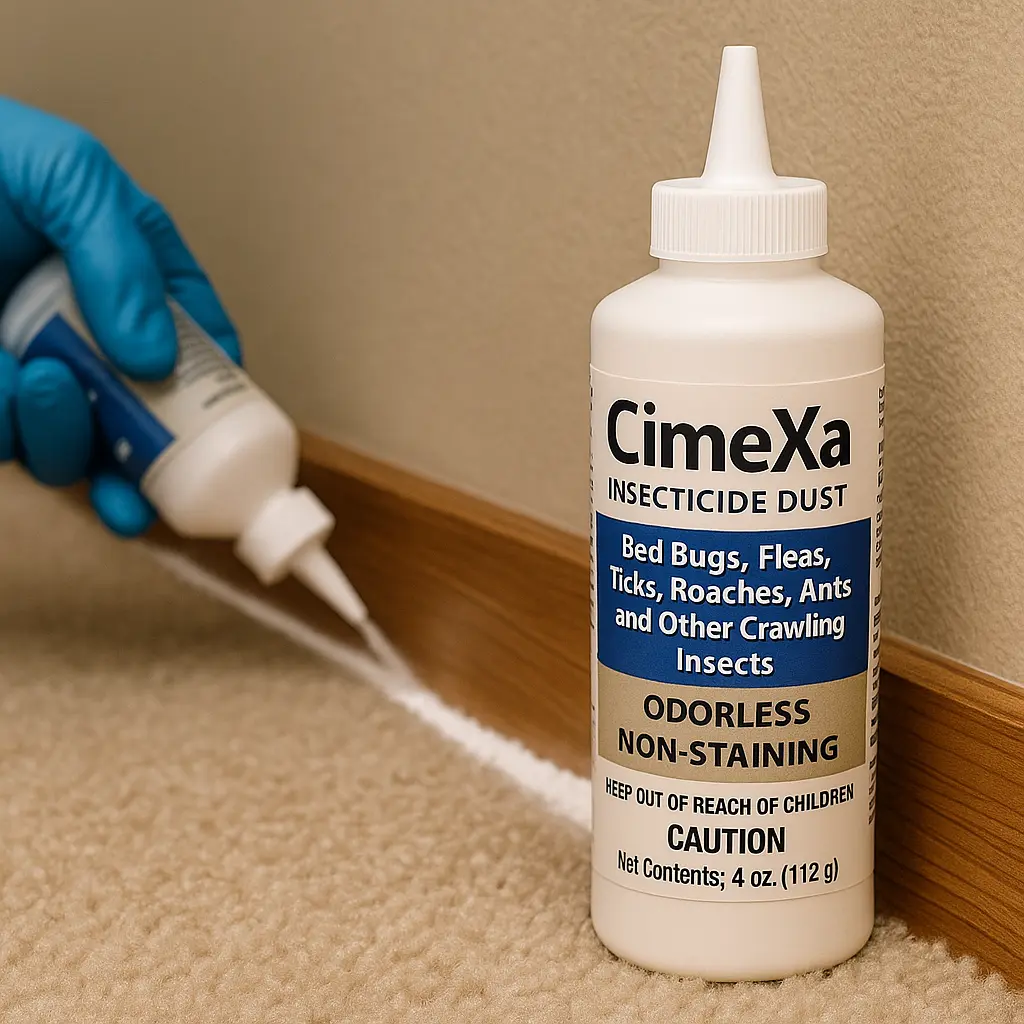Is CimeXa Safe? Understanding the Health Risks of This Popular Bed Bug Killer.

CimeXa is one of the most recommended professional-grade bed bug powders available to consumers. It’s known for its long-lasting effectiveness and low toxicity, but is it truly safe to use in your home?
Let’s take a closer look at what the research and experts say about CimeXa’s health risks, how it compares to other products like diatomaceous earth, and how to use it safely.
What Is CimeXa?
CimeXa is a desiccant dust made of amorphous silica. It kills bed bugs by sticking to their exoskeleton and dehydrating them to death. It doesn’t rely on toxic chemicals or insect growth regulators, which makes it a favorite among pest control professionals and DIYers alike.
According to Rockwell Labs, the manufacturer, it’s:
- Non-staining
- Odorless
- Low-toxicity to humans and pets
- Highly effective for up to 10 years in undisturbed areas
Is CimeXa Dangerous to Humans?
The Good News:
CimeXa uses amorphous silica, which is not the same as crystalline silica, the form linked to lung disease and cancer. Amorphous silica is not classified as a carcinogen, and the CDC/NIOSH has stated that it presents a far lower risk than crystalline forms when used properly.
“CimeXa Insecticide Dust is composed of engineered amorphous silica, not crystalline silica… it poses no known chronic inhalation hazard.”
— Rockwell Labs Tech Bulletin
The More Serious Concern: Inhalation During Application
Even though amorphous silica is considered low-risk, inhaling fine dust particles can still irritate your lungs, especially during or immediately after application.
The Rockwell Labs notes several first aid measures if Cimexa is inhaled or swallowed.
If inhaled:
Move person to fresh air. If person is not breathing, call 911 or an ambulance, then give artificial respiration, preferably mouth to mouth if possible. Call a poison control center or doctor for further treatment advice.
If swallowed:
Call a poison control center or doctor immediately for treatment advice. Have person sip a glass of water if able to swallow. Do not induce vomiting unless told to do so by a poison control center or doctor. Do not give anything by mouth to an unconscious person.
The CDC also recommends limiting airborne exposure to any silica dust, especially in enclosed or poorly ventilated areas.
Reported Side Effects from Real Users
While long-term studies show no chronic harm, some DIY users have reported:
- Mild coughing or sore throat during or after application
- Dry hands or mild skin irritation from handling
- Accidental exposure causing discomfort in pets or children if not properly applied
You can find several user experiences on threads like this Reddit discussion — while anecdotal, they’re helpful for understanding real-world usage mistakes and how to avoid them.
Is It Safer Than Diatomaceous Earth?
In short: yes.
Many people confuse CimeXa with diatomaceous earth (DE), another dust-based bed bug treatment. However, some forms of DE contain crystalline silica, which is linked to long-term lung damage like silicosis.
The National Pesticide Information Center notes:
“Inhalation of crystalline silica over long periods can cause scarring of lung tissue and breathing problems.”
CimeXa avoids this issue entirely by using pure, engineered amorphous silica.
How to Use CimeXa Safely
To minimize health risks, follow these best practices:
Recommended Safety Gear:
- N95 or P100 respirator
- Gloves
- Eye protection
Application Tips:
- Apply lightly — a thin visible layer is enough
- Turn off HVAC/fans during treatment
- Let the dust settle before re-entering rooms
- Vacuum excess from exposed areas like nightstands or floors
- Keep children and pets away during and after application
For full application guidance, see the CimeXa Application Methods & Tips
Final Takeaways
| Question | Answer |
|---|---|
| Is CimeXa toxic? | No, it’s considered low-toxicity and non-carcinogenic |
| Can I breathe it in? | You should avoid inhaling any dust — wear a respirator |
| Is it safe around pets/kids? | Yes, after application and settling — not during use |
| Is it better than diatomaceous earth? | Yes, it’s safer and more effective for bed bugs |
Sources
- Rockwell Labs CimeXa Technical Bulletin (PDF)
- NPIC – Diatomaceous Earth Fact Sheet
- CDC/NIOSH – Occupational Exposure Limits for Amorphous Silica
- How I’m handling bed bugs: camping at home, with Cimexa around the mattress.
- CimeXa Application Methods & Tips
CimeXa is powerful, long-lasting, and generally safe — but like any pest control product, it’s only safe when used properly. Take your time, protect your lungs, and treat it with respect.
Did you survive bed bugs?
We’re building a collection of stories about surviving bed bugs. Got a story? We’d love to include it.
Share your story